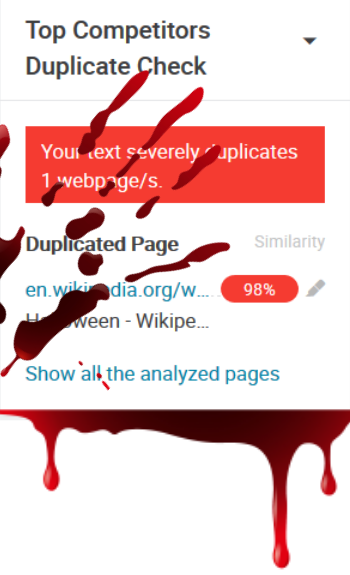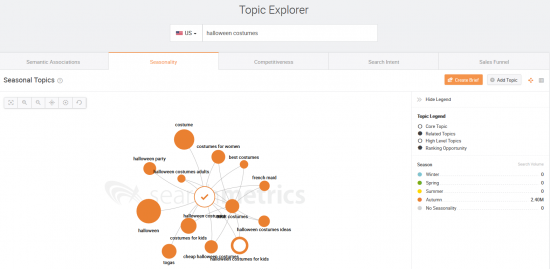A guest article by Gidon Wagner, Wortliga.de – Let’s face it, content marketing can be a frightening business. It’s often hard to measure how much your earned media content reaches and resonates with targeted audiences. Any little slip-up can make you a member of the walking dead. For Halloween, we’re serving up a few tips on how not to get buried by the little things that scare users away.
Content & Technical Ranking Factors 2018

Who’s Watching?
Two early indicators of content success are Time on Site and Bounce Rate. These metrics give you answers as to how long the average user engages with your content and offer indicators as of how relevant your content is– key metrics that Google and other search engines use to rank your content against others’.
Once a visitor lands anywhere on your site, the key to scoring conversions with them often is to get them to take a full tour of everything you have to offer. Beyond calls to action such as requesting demos and filling out forms, “sticky” content is a must for staying ahead of competitors. Here are five strategies that can scare users away in an instant.
1. Create Confusion and Terror
Low bounce rate good; high bounce rate bad. To achieve high bounce rates, confuse your readers at first sight and offer them none of the content they need to answer the question that brought them your way.
Something wicked this way comes if you bombard the reader with too many welcome messages, overt sales pitches, oversized display ads and text teasers or “Fake News!” headlines that have little to do with the content attached.
TIP: The average person reads 250 words per minute. Those first 10 words have to grab them; users leave a website after just 3 seconds of reading.
2. Be Repulsive
What’s equally deadly? No doubt it’s slaying your reader with poor sentence structure and weak context. Avoid passive sentence construction. Alternate between short and long sentences. If you’re really intent on boring readers to death, be as broad and bland as possible by avoiding tips, takeaways, summaries and illustrations.
3. Deceive and Delude
An even more perfidious (and long-term) way to scare users away is to deceive and delude by creating a website that seems to be helpful and intriguing at first sight and reveals it fecklessness later on.
For the best in horror, try clickbait headlines. Create previews, social shares and text teasers as grandiloquent and revolutionary as possible – only to completely let the user down when it comes to the actual text. Besides a rather superficial outline of the text, advertorials in poor disguise instead of rich advice should do the trick here.
Fool the reader once, shame on them. Fool them twice, shame on you. They’re likely not to come back a third time.
4. Create Content Clones and apply the Frankenstein-Method
Duplicate Content is another great way to be as irrelevant as possible in the eye of the user. While you have minimal workload because you simply copy paste your competitors’ content, you create maximum scary impact by sending you user directly to the house of mirrors – and once they find their way out, it is very likely that they never come back.
A more subtle but maybe even scarier method is what I call the Frankenstein method. Here, you don’t simply copy a whole other text, but steal bits and pieces from several other articles which makes you seemingly unique. For the users of your website, the true monstrosity is only revealed at the closer look: Besides completely different approaches and stiles it is especially a the incoherence of such texts which prohibit an enjoyable flow of reading.
5. Booh – use the element of surprise wisely
Using the element of surprise wisely is one of the most sophisticated tactics to scare a user away. What you want to look for are opportunities to appear out of the blue in a context where a potential customer would expect you least. The more visible the placement, the bigger the scare – PopUps or full video placements in a misfit to the actual content of a page almost guarantee your bounce rates to skyrockets, while your CTR will drop significantly.
If you’re using a content calendar to plan your content and match it to user intents that differ throughout the seasons you should get rid of it as soon as possible or at least give it a good shake. If you have already tried to sell Christmas trees in July or launch Summer-Campaign in the fall you will know that seasonal insignificance is key to an irritated audience.
Back from the Dead: Measuring Content Success
User Signals like Bounce Rate or Time on Site, as well as Click-through-rate (CTR) and Social Shares, can easily be measured with free tools like Google Analytics and should be the first metrics every content marketer, blogger or website manager consults on daily basis for indicators of success.
While the ex-post approach aims at analyzing content performance after publishing to incorporate the findings iteratively into the underlying content-marketing-strategy, a newer approach seeks to identify topics that will be relevant to the user, and rank well on search engines, before publishing.
Within the Searchmetrics Content Experience, there is an aggregated metric called the Content Score, to determine whether a piece of content meets the users expectations. Factors that go through the algorithm include text length and how comprehensively the writer covers a topic compared to similar content on competing websites. The platform also follows Google and other search engines in examining content uniqueness and readability.
Killing It with Your Content
Halloween puns aside, I’ll wrap with a few treats that could help you murder the competition. If your answer to these questions is generally “yes”, you’re on the right track. For any “no” answers, you might want to take a closer look at how to address the issue:
- Does the text attract a specific target group?
- Do the first 10-20 words address a tangible need?
- Do the first 3 paragraphs deliver what headline and introduction promised?
- Does the text deserve likes, shares and rankings?
- Is the text conforming with your marketing goals?
- Are there any redundant elements?
- Is this an innovation?
- Is the text partitioned and scannable?
- Did we cite sources where needed?
- Can you understand most of the sentences without reading them twice?
- Would you recommend the text to someone with a similar problem or need for information?
- Would you share the text publicly on Facebook, Twitter or LinkedIn?





